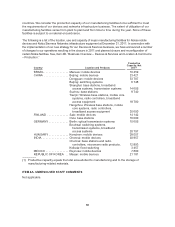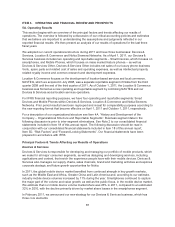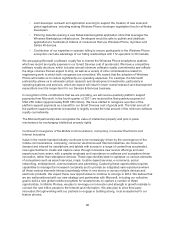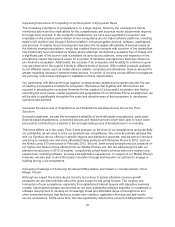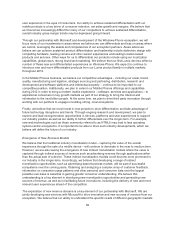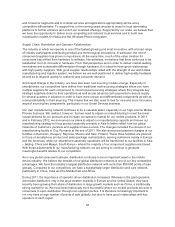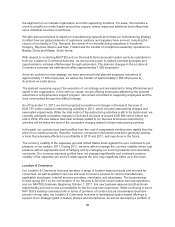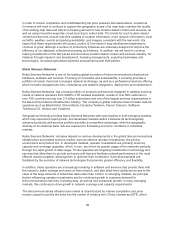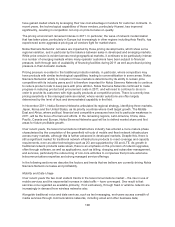Nokia 2011 Annual Report Download - page 95
Download and view the complete annual report
Please find page 95 of the 2011 Nokia annual report below. You can navigate through the pages in the report by either clicking on the pages listed below, or by using the keyword search tool below to find specific information within the annual report.and consumer segments and to localize services and applications appropriately will be a key
competitive differentiator. To support this, in the coming years we plan to invest in local advertising
platforms to further enhance and enrich our localized offerings. Supported by our scale, we believe that
we have the opportunity to deliver more compelling and relevant local services and to build new
monetization models for Nokia and the Windows Phone ecosystem.
Supply Chain, Distribution and Operator Relationships
The industry in which we operate is one of the fastest growing and most innovative, with a broad range
of industry participants contributing product and technological innovations. In particular, the role of
component suppliers has grown in importance. At the same time, much of the value creation for
consumers has shifted from hardware to software. Nevertheless, we believe that there continues to be
substantial room to innovate in hardware. From that perspective and in order to deliver market-leading
innovations and sustainable differentiation through hardware, it is critical to have good relationships
with high quality suppliers. With good supplier relationships, allied with the strength of our world-class
manufacturing and logistics system, we believe we are well-positioned to deliver high-quality hardware
as well as to respond quickly to customer and consumer demand.
Amid rapid change in the industry, we have also seen new sourcing models emerge. Especially in
smartphones, our competitors have shifted from traditional multi-sourcing strategies where you have
multiple suppliers for each component, to more focused sourcing strategies where they integrate key
strategic suppliers closer to their operations as well as use advance cash payments to secure supply
for several quarters in advance in order to have more unique and differentiated components as well as
more predictability in their sourcing. This means that we also need to look for new and more innovative
ways of sourcing key components, particularly in our Smart Devices business.
Our own manufacturing network continues to be a valuable asset, especially in our high-volume Mobile
Phones business. We realized, however, that we need to adjust our manufacturing to meet the lower
overall demand for our products and increase our speed to market for our mobile products. In 2011
and in February 2012, we announced our plans to adjust our manufacturing capacity and renew our
manufacturing strategy to focus product assembly primarily in Asia to better reflect how our global
networks of customers, partners and suppliers have evolved. The changes included the closure of our
manufacturing facility in Cluj, Romania at the end of 2011. We also announced planned changes at our
facilities in Komárom, Hungary, Reynosa, Mexico and Salo, Finland. These three facilities are planned
to focus on smartphone product and sales package customization, serving customers mainly in Europe
and the Americas, while our smartphone assembly operations will be transferred to our facilities in Asia
– Beijing, China and Masan, South Korea – where the majority of our component suppliers are based.
With these adjustments to our manufacturing network, we are aiming to continue to generate
meaningful benefits relative to our competitors.
As in any global consumer business, distribution continues to be an important asset in the mobile
device industry. We believe the breadth of our global distribution network is one of our key competitive
advantages. We have the industry’s largest distribution network with more than 850 000 points of sale
globally. Compared to our competitors, we have a substantially larger distribution and care network,
particularly in China, India and the Middle East and Africa.
During 2011, the importance of operator-driven distribution increased. Whereas in the past operators
dominated distribution only in the large western markets in Europe and the United States, they have
recently been growing their share of distribution in large growth markets such as China, a traditionally
strong market for us. We have been historically more successful where our mobile products are sold to
consumers in open distribution through non-operator parties. It is therefore increasingly important to
not only have a large number of points of sale globally, but also to have good relationships with key
operators in each region.
93





